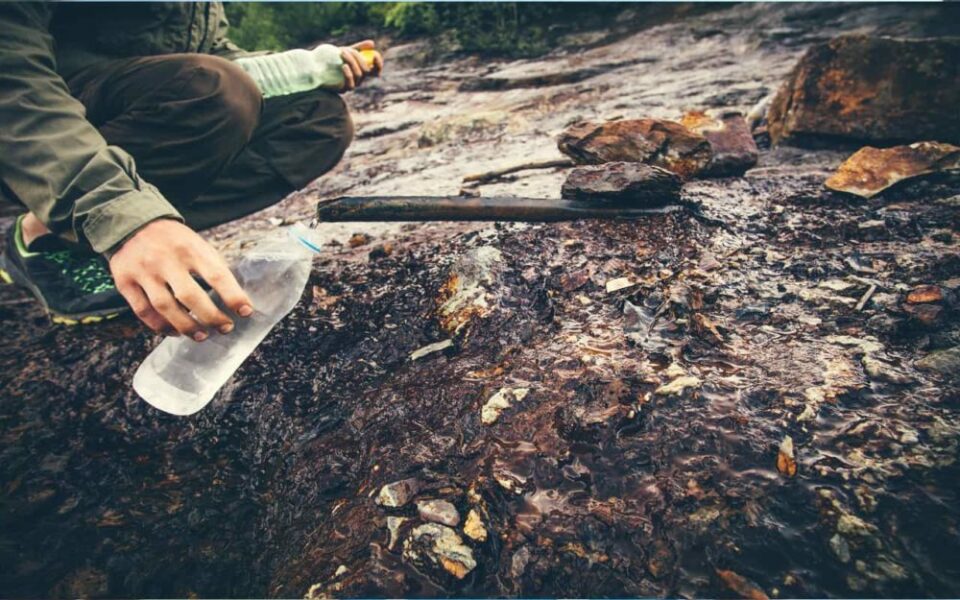We are long in a perilous era, an era where our world is ready to come crumbling down at any moment – be that the result of natural disasters, all-out war, or just bad luck. So you should try to do anything, at least to some degree, possible to survive in an emergency. And the thing most important to humanity except the air is water.
If you do ever end up in an emergency without water, though, you can’t simply find a source of clean water just sitting out there. And even if you find something like a river or a puddle, this isn’t a very good choice, as random water sources can often be loaded with parasites and other nasty organisms like bacteria and virus cells that can lead to far more catastrophic consequences than you can think of. And all of that for a sip of water.
That’s why you shouldn’t risk your life, and you should always have some way to clean out any unwanted and harmful things – a survival filtration and/or purifying device.
1. MSR MiniWorks EX Purifier
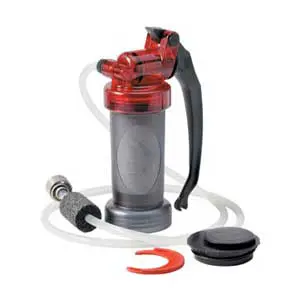
On the less expensive end, we have the MSR MiniWorks EX purifier system. This system combines a filter and a purifier for better virus protection. And like its bigger brother, the MSR guardian, it is fully committed to designing field-serviceable equipment.
This filter is special because you can disassemble the entire filter without tools. A toolless disassembly allows you to clean or replace the filter anywhere, anytime. In fact, regular cleaning of the surface of a ceramic filter core helps the filter to remain easy water flow through the filter/purifier cartridge is good for about 2 000 liters, so carrying two or three with you is a no-brainer.
Though the cost of the system itself is pretty affordable, the replacement cartridges will add up significantly over time, resulting in a very hefty price, especially if you use it every day. Also, while the two-step treatment workflow is a much safer way for filtration, it is a bit clunky.
The MSR MiniWorks EX purifier is ideal for small group water treatment and perfect as a temporary portable filter that won’t see a ton of use. So if you’re on a tight budget, you can afford something like the MSR guardian, and you want something reliable, this is the best choice.
2. Survivor Filter PRO
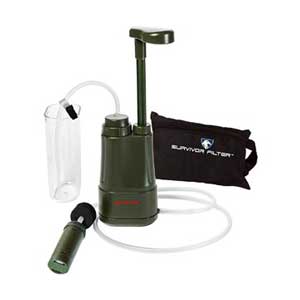
If you want a pump filter that will protect you against viruses while still pretty cheap, this is the one for you. The tiny 0.01-micron hollow-fiber/carbon filter can pack 99 000 liters, capacity-achieving anything you don’t want in your water.
But its small price means that the company needed to cut some corners. While it is still pretty lightweight, it’s made out of low-quality plastics, which is a big concern for pump-style filters, so don’t it to survive out in the wild.
And all of that adds up to a pretty good product, a pump for filtrating water is the best choice for people on a very strict budget.
3. Sawyer Mini Filter
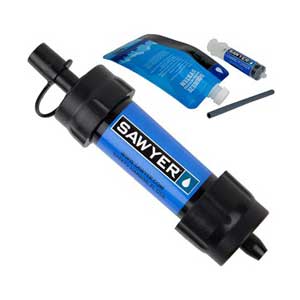
This tiny water filter has the capacity of 378 000 liters (100 000 gallons) of water through a 0.1-micron filter, which is a LOT.
The hose adapter on both ends of the sawyer mini makes it much more versatile than any competitors. It gives you many options, like splicing it into a water pouch, converting it into a gravity filter, or even using the hose to get to hard-to-reach spaces like cracks in the ground. The sawyer mini has a threaded end that screws onto a small bladder to let you filter and drink on the move.
Suffice it to say that this price, combined with its high quality and feather-like weight, make the sawyer mini an excellent survival water filter for daily use or emergencies.
4. MoKo Portable Filter
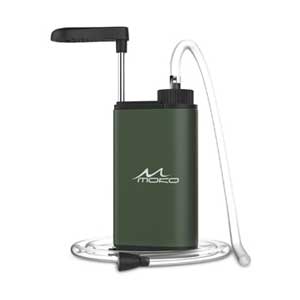
This portable water filter features the highest water safety standard, 0.01 Micron 3 ultra purification stages remove 99% of pathogenic substances, volatile organic compounds (VOC), and other harmful contaminants.
It is is is very small and easy to transport while also being lightweight enough to carry anywhere. Ideal for camping, hiking, backpacking, trekking, mountaineering, emergency, and other outdoor adventures. It features a three-level filtration process using not only the standard ones but also a carbon filter to ensure your water is not only safe but also looks like water.
Overall, with all those filter features, including the coconut carbon one and the amazingly fast flow rate4 of 600ml per minute, you’ve got a fast but functional and very portable filter on your hands.
5. LifeStraw Family Purifier
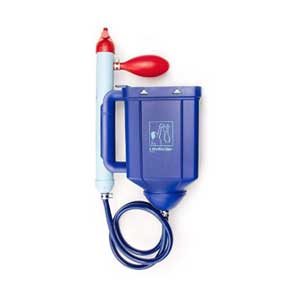
Here we have an offering from LifeStraw – one of the few Gravity filters with the astonishing 0.02-micron filter and a bag that can pack 3 gallons and a filter lifespan of about 18 000 liters. Its more rigid water container makes it bulkier than its competition, thus making it less portable, but on the other hand, it is also more prepared to survive unwanted accidents.
A great advantage of the filter is that it provides all the EPA filtrations standards. Still, without the use of any chemicals, so theoretically, it can last up to three years of consecutive uses for a family of three. There is one caveat, though, and it stands for the fact that the filter is a gravity one – its flow rate is painfully slow. While in some other filters, you can get a liter in just a minute and a half, and here you can get only nine in a full hour.
Suffice it to say, we have another great product from LifeStraw, and though it has a little caveat, if you look past it, it’s one amazing piece of survival gear.
What Makes a Good Survival Filter And How to Choose One?
Like all tools out there, survival water filters have some characteristics that make them better than others, so here we are going to look at each of the types out there, their pros and cons, and some additional information to help you make an informed choice.
Filters vs. Purifiers
Most people use the terms water filter and water purifier interchangeably. While both are water treatment technologies, survival filters and purifiers are different, using two types of technology that also pack different features.
Water Filters
Survival water filters are like sieves with very, very tiny holes that are evaluated in micrometers (microns for short). These holes trap contaminants, so only clean water can pass through.
Most water filters have holes that are around 0.1 or 0.2 microns in size. This is enough to keep out bacteria and protozoa. However, most survival water filters will DO NOT remove virus cells, so most of them aren’t considered purifiers.
Water Purifiers
A purifier, on the other hand, is a water treatment system that can also treat the virus and bacteria, and protozoa. One type is UV pens. They are very popular and inexpensive. Water treatment tablets are another common type of water purifier.
Highly effective are those systems. They’re not removing sediment from the water, however. You might collect a cup of water from a swamp, for example, and drink it safely, but the mud and dead bugs or splinters would still be in the water, and it’ll taste awful, too.
As we touched on above, water filter technology has greatly improved in the past few years. So nowadays, several survival water filters have filter hole sizes small enough to remove viruses, so they can also be considered as purifiers and the best of both worlds. They are mostly chemicals, but they can be found in water.
What Do Water Filters Treat?
You must think about what types of contaminants might be in the water you want to treat before choosing a survival water filter. Not all water filters remove the same things.
Here I’ll list all of the things you will want to avoid, and you can remove by using a filter, just to be informed about what you are fighting with.
Protozoa
Protozoa are unicellular organisms. The dormant protozoan form is called cysts. Cryptosporidium and Giardia are the most notorious ones found in water. Protozoa are very common in water, even filtered water that is “clean,” and are responsible for causing terrible diarrhea to many backpackers.
The good news is that protozoa are quite large, and their cysts. The majority are about 2 to 50 microns in size, and for example, Giardia cysts are about 7- microns, so even cheaper water filters can be removed with only one nominal evaluation.
Bacteria
Also, bacteria are single- organisms but can be much smaller than protozoa cysts. Usually, they are about 1- micron long and 0.2- microns wide. So you need a water filter with an absolute filter evaluated at 0.2-micron or less to be sure that bacteria are out of the picture.
Viruses are minuscule. Very diminutive. Most viruses are in the size of 0.01-0.3 microns. There are nonetheless virus cells as small as 0.004 microns. This makes infections very difficult to filter. Even water filters that say viruses are removed will not be able to remove every single type of infection.
Rotavirus is 0.070 microns. Hepatitis A and E are 0.027 microns. Norwalk virus is 0.027 microns.
The good news is that in backcountry water, viruses generally aren’t a problem. Only cholera and polio can survive and reproduce in water, and even then, the sun’s UV light can usually kill bacteria.
However, in disaster situations like flooding or an earthquake, virus cells from sewage contamination can become a huge risk. Thus, a normal water filter is just a no-go.
You need to worry about the virus in water in urban areas, though, because in those areas, it can spread very quickly. In undeveloped countries, the situation is almost the same, except that virus spread happens because of poor sanitation.
So, be careful where you run off in an emergency, and be prepared to manage your water where you have settled off, too.
Chemicals
Natural disasters – especially floods – can lead to the contamination of water sources by huge quantities of chemical substances. For example, more than 40 sites released hazardous pollutants after Hurricane Harvey.
Most water filters can remove heavy metals such as lead and iron because the particles are so large. Chemical pollutants, such as benzene and pesticides, are, however, very small, and even the best filters out there can not do anything.
For example, benzene is only slightly larger than a molecule made of water. So no water filter will be able to filter out benzene. Those chemicals can only be absorbed by activated charcoal to reduce them.
In addition to the main filter, many survival water filters now also have carbon pre-filters, which enable you to remove heavy metals and pesticides.
Just note that activated carbon is quickly filled up (it can not be cleaned like a membrane filter with backflushing). The carbon filter will often have to be changed to remain effective.
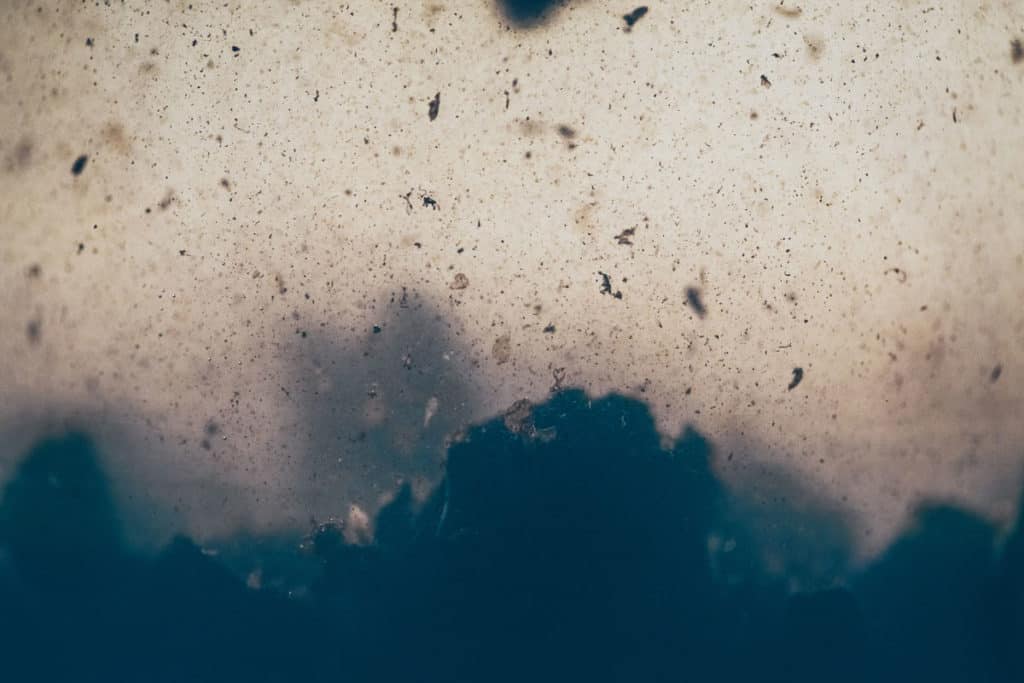
What are the most common types of filters?
There are many different options and styles of survival water filters for direct consumption, like straw ones, to ones with containers, like gravity ones. So here are all the types of water filters and all their pros and cons.
Home Water Filters
The water filter you have in your home for treating tap water isn’t made to remove bacteria or protozoa.
These home water filters typically use activated carbon to absorb chemicals and heavy metals such as chlorine, lead, and mercury, thus reducing their amount in your water but not completely removing them. This isn’t true for survival water filter membranes, which completely BLOCK bacteria, etc. from passing through.
The activated carbon in-home water filters will also absorb some bacteria and protozoa, but not to the extent of survival ones, cause tap water is most usually pre-treated with chlorine to kill any living organism, so it is pretty clean in itself.
It only takes a small number of bacteria or protozoa to make you sick, so home water filters should only be used in the worst scenario possible, where other filtration methods aren’t available.
Straw Filter
This is the most compact and inexpensive way to get a survival-grade water filter. It allows you to drink water straight from the source by squatting down to it and sipping through the straw.
A great disadvantage to these types of filters is that they don’t have a container included; in some situations, this is very bad. For example, let’s say you’re in the backcountry and need a way to mix powdered electrolytes for nutrition, but the only way to do this is to swallow them and try to gulp enough water to activate them.
The only way to make straw-style filters function on the move is to put contaminated water into water bottles and then use the straw for drinking from it. But then you can end up with a contaminated bottle, and that’s a whole other problem in itself.
While the filter is pretty easy to use, it doesn’t take a lot of space in your backpack, leaving room for more important things, and is pretty cheap, it can’t filter water as good as some more fleshed-out filters, and you can’t carry the water with you.
Squeeze Filters
Recently, squeeze filters, a variation of the normal hand pump, have become a popular choice for the best water filter.
They work by placing water in a collection vessel, such as a bottle or a pouch, and then screwing the filtering mechanism onto the vessel. After that, you squeeze the pouch physically, forcing the water through the filter so clean water on the other side comes out.
Because a pump mechanism is not required, the squeeze water filters are incredibly lightweight and tiny. They are also very simple and adaptable, so you can, for example, fit them with straws to drink directly out of the water source or attach them to a water bladder to make a filtration system for gravity.
Suffice it to say, like the straw filters, squeeze filters are small, lightweight, and affordable, but they can also be cleaned with backflushing. But if you are with your family, it isn’t very efficient, and its low flow rate is a huge drawback too, so if you want something easy to use that is still cheap and reliable, this is a pretty excellent choice.
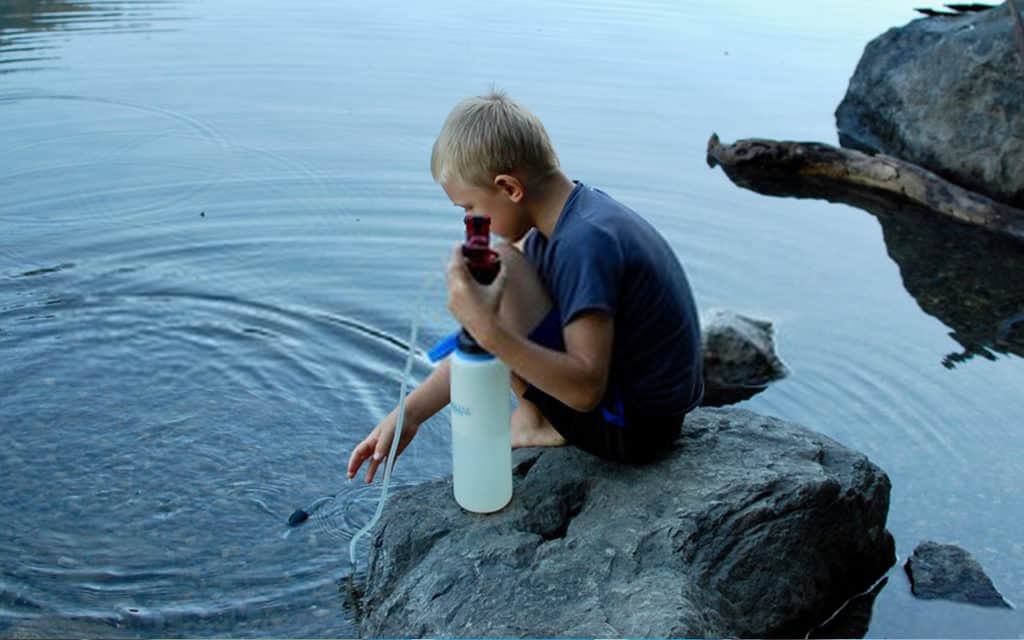
Bottle Water Filters
There are some bottled water filters where a squeeze or straw-type filter is inserted into a bottle to suck or squeeze clean, treated water, but these are more suitable for straw and squeeze types, respectively.
The real filters for Bottle water are a whole different story. You put contaminated water in the bottle, then push the filter into the bottle, and all the contaminants are pushed down, and the bottle’s top portion is full of clean water. You can drink from the bottle right away or pour the clean water into another container.
While yet aren’t as portable as the straw or squeeze filters, bottle ones are still lightweight and very much portable. Though they are a bit bad at filtering large amounts of water or being used in shallower water sources, their simplicity and low price make up for that.
Hand Pump Water Filters
This type of water filter is a bit bulkier than the other ones, but it also comes with some much more wanted features too.
They aren’t much more complicated to use than the other ones we’ve looked at so far. You just put one end in the water source, and then you start pumping by hand. The pump then pulls the water up and through a filter cartridge resulting in clean water on the other end.
This here may be the best option for a water filter that has little to no compromises. Unlike the bottle, survival pump water filters can access shallower water sources while also coming in various sizes, from ones for only to ones for the whole family. Not only are there models that are tailor-made to remove virus cells from your dirty water, but it also does the filtration fairly quickly without needing a collection vessel.
The only major disadvantage is that even the smallest ones are a bit bigger for single-use, but they have many great features making them an excellent choice for any occasion.
Gravity Filters
Gravity filters have become more popular recently, especially for casual activities like family camping.
To use one, you simply put dirty water inside the pouch and then hang it somewhere high up, like on a tree branch. Gravity forces the water down through the filtering mechanism, and clean water comes out on the lower side.
To sum it up, these waters aren’t the best ones for emergencies. Yes, they can filter a lot of water at once without the need for physical work, but they aren’t suitable for all water sources. It takes a very long time to filter, and all of that, combined with the fragile pouches and the need for a high enough place, makes it too needy to be convenient.
Final Words
So, suffice it to say no matter how you twist the emergency you may fall into, a clean water source is something you should always have.
Thus a water filter, no matter the type you have chosen, must have a place in your bag of survival equipment. Because while you can survive the harsh cold weather of winter, or two or three days without any food, without hydration, your life will be over before you can think about it (also, it helps with the taste, too). If you want to add something to the article, just leave a reply below.


